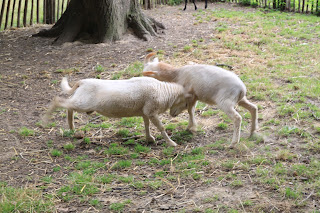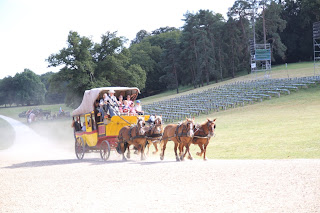After Guédelon, we drive deeper into Burgundy with our visiting friends to take a relaxing break from our previous break, picking wildflowers, a.k.a weeds, on the lawn of Sully castle, which dates roughly from the 14th century. It turns out to be a private residence, and we are 99% sure that the woman we meet going in and out of the imposing doors is the Duchess of Magenta. She explains the carvings of boar on the door, with a very posh Queen's English accent, saying that "the owners were very keen on hunting." At first I am very impressed with how well she speaks English. Then I learn she is Scottish. In any event, I feel I can now boast that I hobnob with royalty.






Here, a view from the castle into the town:









Perhaps our favorite day in Burgundy is spent biking along old train tracks that have been converted into a "voie verte" or "green track". It's relatively flat, with beautiful French countryside, almost no traffic to worry about except at a couple small crossings, and views of the occasional castle popping up in the distance. ("Shall we ride to the castle, kids?" "Nooooooo!!!!") But at one point, Pippa's brakes break. We have the tool kit on our rental bikes; but as it is only us two non-mechanical moms and four kids, we very nearly call the rental company to come help us. Luckily, just before that happens, we swallow our pride and ask a man riding by in full racing gear for help. Within seconds he realizes that Pippa has accidentally wound the brake cable around her handlebars. He twists her handlebars around, and we're good to go. It is embarrassing, but much better than it would have been if we'd made somebody drive out to us from the rental shop.





Then we visit the little town and castle of La Rochepot, so magical that the entire minivan literally gasps when it comes into sight. The 13th century castle itself is, to me, one of the more unusual and memorable in all of France, because of the colorful tiles typical of the Burgundy region.




Here, a view from the castle into the town:
Since the children are less than thrilled with any more historical sites ("Oh, noooooo! Not another castle!"), we find we need to take frequent breaks from the break we are taking. After an arduous half-day of touring around and eating ice cream, the hotel swimming pool is a welcome relief. Even our hotel looks like a little castle, however, with gorgeous grounds, and an indoor-outdoor pool, all in an adorable little village with several excellent restaurants less than 20 steps away. I just have to put a plug in and say that at around 70€ per night, the Logis de Trois Maures in the town of Couches (pronounced "koosh" not like the word that means "many sofas") may be the biggest hotel bargain I've ever come across.




One of those neighboring restaurants, La Tour Bajole, is in a monastery from the 12th century, converted at some point within the last 900 years into a restaurant. Food -- delicious; service -- friendly; ambiance -- jaw-dropping.

Even the children appreciate it to a degree and also admit, begrudgingly, that this little town of Semur-en-Auxois out-Disneys Disneyland. This is high praise indeed, but we get this concession from them only as long as what we do here is simply eat ice cream, and not actually go inside any historical buildings.


One day, we take a break from relaxing to try to educate ourselves by visiting the city of Autun, which is supposed to have "rivaled Rome" in its heyday. But rivaled Rome in what, we ask? Watermelon seed spitting contests? Armpit farting? Because it sure wasn't about the constructions or the ruins. There are the remains of an amphitheater, with excellent acoustics, and two remaining gates to the city. Supposedly, there is also a Temple to Juno, but no amount of GPSing, sign-post following, or asking directions from locals can get us there.


Perhaps our favorite day in Burgundy is spent biking along old train tracks that have been converted into a "voie verte" or "green track". It's relatively flat, with beautiful French countryside, almost no traffic to worry about except at a couple small crossings, and views of the occasional castle popping up in the distance. ("Shall we ride to the castle, kids?" "Nooooooo!!!!") But at one point, Pippa's brakes break. We have the tool kit on our rental bikes; but as it is only us two non-mechanical moms and four kids, we very nearly call the rental company to come help us. Luckily, just before that happens, we swallow our pride and ask a man riding by in full racing gear for help. Within seconds he realizes that Pippa has accidentally wound the brake cable around her handlebars. He twists her handlebars around, and we're good to go. It is embarrassing, but much better than it would have been if we'd made somebody drive out to us from the rental shop.





































